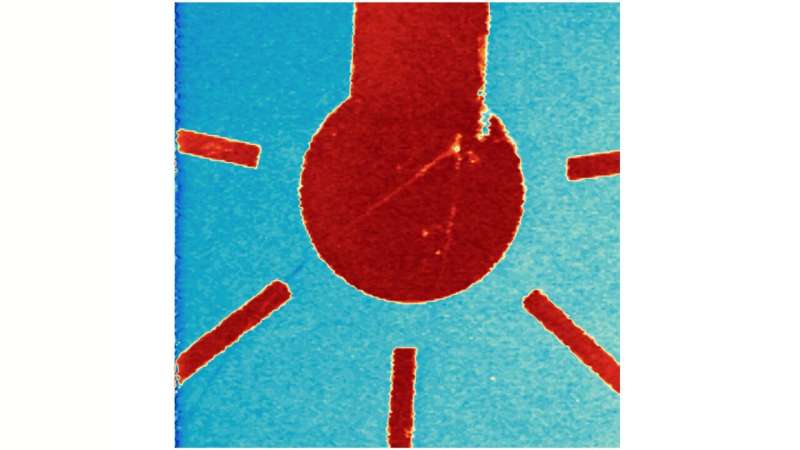October 12, 2023 feature
This article has been reviewed according to Science X's editorial process and policies. Editors have highlighted the following attributes while ensuring the content's credibility:
fact-checked
peer-reviewed publication
trusted source
proofread
Elevating neuromorphic computing using laser-controlled filaments in vanadium dioxide

In a new Science Advances study, scientists from the University of Science and Technology of China have developed a dynamic network structure using laser-controlled conducting filaments for neuromorphic computing.
Neuromorphic computing is an emerging field of research that draws inspiration from the human brain to create efficient and intelligent computer systems. At its core, neuromorphic computing relies on artificial neural networks, which are computational models inspired by the neurons and synapses in the brain. But when it comes to creating the hardware, it can be a bit challenging.
Mott materials have emerged as suitable candidates for neuromorphic computing due to their unique transition properties. Mott transition involves a rapid change in electrical conductivity, often accompanied by a transition between insulating and metallic states.
Co-lead author Prof. Chong-Wen Zou explained to Phys.org, "The pronounced electron-electron behavior in Mott materials leads to several orders of magnitude changes in conductivity over a very narrow temperature interval or even superconductivity."
In their study, the team chose vanadium dioxide (VO2). Explaining their choice of material, co-lead author Fang-Wen Sun said, "VO2 is a typical Mott material with the phase transition temperature near room temperature, thus possessing the feasibility for a variety of applications."
VO2 as an electrical switch
VO2, like all Mott materials, undergoes metal-insulator transition (MIT) at around 68° Celsius (154° Fahrenheit). This means that at this specific temperature, VO2 changes from being an insulator to a conductor. The ability to switch between these states makes VO2 suitable for various applications.
What makes VO2 ideal for neuromorphic computing applications is its MIT behavior, which mimics the behavior of biological neurons. In simpler terms, VO2 exhibits changes in electrical conductivity, similar to how the strength between biological neurons in the human brain can change.
This similarity to the brain's plasticity means that VO2 can adapt and change its conductivity, just like the brain adapts and rewires itself. Additionally, VO2's exceptional ability to switch between conducting and non-conducting states makes it a valuable component for electrical circuits, acting like an efficient switch.
The flow of electricity and light through VO2 materials can be controlled based on temperature, making them ideal for other applications. This is especially useful in applications like smart windows, allowing the control of light and heat passing through, enhancing energy efficiency.
Furthermore, VO2 can be used to construct dynamic networks where signals can be processed and stored in a way that imitates the functionality of the human nervous system, especially in terms of adaptability and response to external stimuli.
Prof. Zou and Prof. Sun explained, "The controlled connections of conducting filaments in VO2 devices are similar to those of the biological synapses. Therefore, we also explored the application of the network organized by the artificial synapses based on VO2 devices in our research."
Focused lasers and quantum sensors
"In traditional artificial synaptic device research, properties of individual synapses are characterized, and these synapses are used as response functions to simulate neural networks. However, our dynamic network, achieved through laser-controlled conductive filaments, exists in hardware, closely resembling the behavior of biological neurons, without relying on semiconductor circuits," explained the researchers.
The research team constructed a highly sophisticated experimental setup to study and manipulate conducting filaments within VO2 materials. They began by growing VO2 films with a precisely controlled thickness of 100 nanometers.
To gain insights into the behavior of the VO2 material, the team utilized quantum sensors based on diamond nitrogen-vacancy (NV) centers known for their exceptional sensitivity to changes in electric conductivity due to atomic defects within the diamond crystal.
These sensors played a crucial role in detecting alterations in the electrical properties of VO2. By manipulating the NV centers, the researchers were able to observe how conducting filaments formed and were controlled. The primary objective of their experiments was to have precise control over the location of the conducting filaments within the VO2 devices, which acted as pathways for electrical signals.
To achieve this, the researchers used focused lasers, precisely directed within the VO2 devices, to manipulate the conducting filaments' location. This level of control was crucial for regulating the flow of electrical signals, resembling the behavior of biological synapses.
Additionally, the team employed high-angle annular darkfield scanning transmission electron microscopy (STEM) to capture high-resolution images and analyze the structure of the VO2 material, gaining valuable insights at the nanoscale.
The expertise of Prof. Sun's group with conducting filaments of nanowires using quantum sensors based on the diamond NV centers, along with Prof. Zou's group, who have focused on the studies of VO2 phase transition and device applications, helped the team successfully image conducting filaments with quantum sensors based on the diamond NV centers by detecting the current distribution.
Future work
The researchers found that the artificial synapses demonstrated long-term and short-term potentiation, with channels re-triggerable by current, lasting over two hours, and featuring transient resistance changes due to laser heating. In simple terms, the artificial synapses exhibited the ability to strengthen and adapt their connections over time, much like how our brain's neural networks learn and process information.
Speaking of the future applications of the work, "In the current demo, we've established a network with five artificial synapses using focused lasers to control conducting filaments," said Prof. Zou.
"Our future goal is to build more complex neural networks using multilayer electrodes and light fields for synaptic connectivity. Challenges remain in creating a feedback mechanism to regulate light intensity, but we're eager to explore practical applications of Mott materials," concluded Prof. Sun.
More information: Ce Feng et al, Quantum imaging of the reconfigurable VO2 synaptic electronics for neuromorphic computing, Science Advances (2023). DOI: 10.1126/sciadv.adg9376
Journal information: Science Advances
© 2023 Science X Network





















